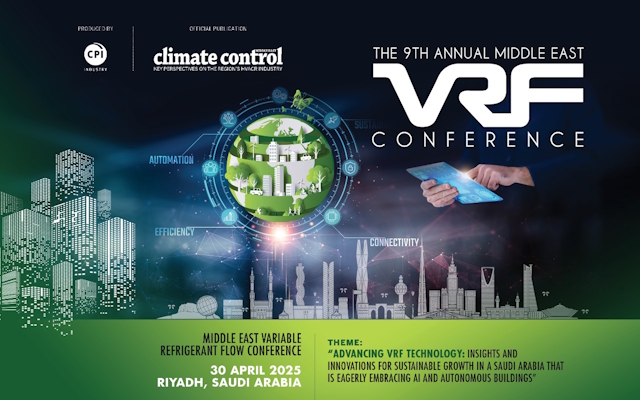

The 9th Edition of the Middle East Variable Refrigerant Flow (VRF) Conference, will shine a spotlight on VRF technology as a cornerstone in achieving sustainable and energy-efficient building strategies in Saudi Arabia. This year, the conference explores two pivotal themes: The integration of VRF systems in autonomous buildings and the regulatory advancements shaping the industry.
Autonomous buildings represent a bold step toward redefining urban living and working spaces, integrating advanced technologies to optimise energy use, comfort and operational efficiency. At the heart of this revolution lies VRF technology, seamlessly paired with IoT-enabled devices and AI-driven building management systems to deliver reportedly strong zone-based cooling, real-time diagnostics and predictive maintenance.
The Kingdom of Saudi Arabia, with its groundbreaking projects, such as NEOM, The Red Sea Development and Qiddiya, serves as a global pioneer in adopting these forward-looking solutions. At the conference, experts will delve into:
The regulatory landscape: Driving innovation and compliance The HVAC industry in Saudi Arabia is experiencing a transformation, spurred by initiatives under the Saudi Energy Efficiency Program (SEEP) and standards established by the Saudi Standards, Metrology, and Quality Organization (SASO).
With cooling accounting for over 50% of electricity consumption in the building sector, regulatory frameworks are becoming increasingly critical to promoting energy-efficient technologies, such as VRF.
Seasonal Efficiency Standards: The adoption of Seasonal Energy Efficiency Ratio (SEER) and Cooling Seasonal Performance Factor (CSPF) metrics to evaluate VRF performance. These measures enable stakeholders to prioritise efficiency and lifecycle benefits over initial costs.
Low-GWP Refrigerants: Regulatory encouragement for the use ofenvironmentally friendly refrigerants, aligning with global climate goals underthe Kigali Amendment.
Performance Testing: Calls for the regional adaptation of global performance testing standards to account for high-ambient conditions and local challenges, such as sandstorms and dust accumulation.
Conference sessions will explore how these regulatory advancements create opportunities for manufacturers, consultants and contractors to innovate while ensuring compliance, ultimately fostering a more sustainable HVAC ecosystem in the region.
Saudi Arabia is poised to become a global leader in VRF adoption and innovation due to several unique factors:
1. Growing demand for energy efficiency
• High Energy Consumption: With air conditioning accounting for a significant portion of energy use in Saudi Arabia’s buildings, there is an urgent need for energy-efficient cooling solutions. VRF systems, with their precise temperature control and reduced energy wastage, are ideal for addressing this challenge.
• Vision 2030 Goals: The Saudi Vision 2030 includes ambitious sustainability targets, driving investments in technologies that reduce energy consumption and greenhouse gas emissions. VRF aligns perfectly with these objectives.
2. Harsh climate and high-ambient conditions
• Need for reliable cooling: The extreme heat in Saudi Arabia, particularly in summer months, makes efficient and reliable cooling systems a necessity. VRF systems are well-suited for this environment due to their ability to maintain consistent performance in high-ambient conditions.
• Innovation in refrigerants: Research and development focused on refrigerants for high-temperature performance further enhance the suitability of VRF systems in the region.
3. Booming construction and urban development
• Mega projects: Saudi Arabia is home to some of the world’s largest urban development projects, including NEOM, The Red Sea Project and Qiddiya, and not to forget the New Murabba. These projects emphasise sustainable and energy-efficient infrastructure, creating a huge demand for advanced HVAC systems like VRF.
• Diverse applications: The need for cooling spans residential, commercial and industrial projects, all of which benefit from VRF’s adaptability and scalability.
4. Regulatory push for sustainability
• Stringent energy standards: Saudi Arabia has implemented regulations that encourage the adoption of energy-efficient technologies, including VRF systems. This regulatory support is catalysing the industry’s growth.
• Incentives for Green Buildings: Programmes promoting green building certifications, such as LEED, incentivise the adoption of VRF systems to meet energy efficiency criteria.
5. Investment in technology and innovation
• R&D in HVAC: Leading VRF manufacturers are increasing their focus on the Middle East market, with Saudi Arabia being a priority. Innovations in VRF technology are tailored to the region’s unique climatic and market needs.
• Smart buildings and IoT integration: Saudi Arabia’s push towards autonomous and smart buildings creates opportunities for VRF systems integrated with IoT and AI, offering energy optimisation and predictive maintenance.
6. Supportive financial ecosystem
• Public Investment Fund (PIF): PIF-backed projects are encouraging the deployment of cutting-edge technologies, including VRF systems, in large-scale developments.
• Infrastructure Investments: With billions of dollars allocated to infrastructure, there’s a growing demand for energy-efficient cooling technologies across various sectors.
7. Market potential and growth
• Emerging market leader: Saudi Arabia’s commitment to sustainability and its robust economic growth position it as a key market for VRF systems in the Middle East and globally.
• Mini-VRFs for residential markets: Growing urbanisation and a rising middle class are creating new opportunities for mini-VRF systems in residential buildings.
By embracing VRF technology as part of its urban and economic transformation, Saudi Arabia is setting an example for other nations looking to combine growth with sustainability. The region’s unique challenges and visionary projects make it a prime incubator for advancements in VRF technology.
aa
aa